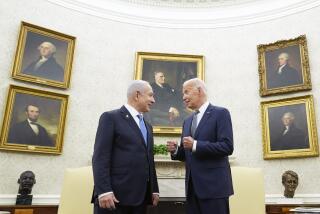CIA Right and Wrong, Documents Show
- Share via
WASHINGTON — Scores of newly declassified intelligence reports from the early Cold War show that the CIA in its infancy was sometimes prescient about events, but other times in the dark.
The spy agency released thousands of pages of Cold War documents recently, most of them intelligence predictions or “estimates” by a growing team of CIA analysts.
Some of the reports proved remarkably accurate about Soviet moves in Central Europe and the victory of Communist forces in China in 1949. At other times, notably before the Korean War, cautious CIA analysts stopped short of predicting hostilities.
By January 1950, five months before the war broke out, the CIA’s Office of Reports and Estimates said, “The continuing southward movement of the expanding Korean People’s Army toward the 38th parallel probably constitutes a defensive measure. . . . An invasion of South Korea is unlikely unless North Korean forces can develop a clear-cut superiority over the increasingly efficient South Korean Army.”
Scholars and retired analysts who attended a seminar on the documents at CIA headquarters said it was too early to tell whether the declassified material contains any nuggets that will change the settled views about Cold War history.
But the documents provide a window into the operating style of an agency charged with informing the president in writing every day about the risks facing the United States around the world.
A 466-page volume published by the CIA that contains selections from the declassified documents, which date from 1946 to 1950, notes that President Truman instituted a daily and weekly intelligence brief and read the reports assiduously. Other officials paid less attention to a document that goes from CIA headquarters to the White House to this day.
Secretary of State George Marshall “stopped reading the ‘Weekly’ after the first issue,” writes Woodrow Kuhns, a former CIA analyst who edited the collection. “Secretary of the Navy James Forrestal considered both summaries ‘valuable but not . . . indispensable,’ according to one of his advisors.”
Preventing another Pearl Harbor-style sneak attack was the primary reason for establishing the CIA in 1947. With this charge, CIA analysts were cautious about predicting war, a position that made them right more often than not.
A memo dated April 2, 1948, is typical of the CIA’s post-World War II assessments of Soviet reluctance to go to war. It concluded: “The preponderance of available evidence and of considerations derived from the ‘logic of the situation’ supports the conclusion that the USSR will not resort to direct military action during 1948.”
That year the CIA had 38 analysts in its Soviet and East European branch. A dozen of them spoke Russian and only one had a doctoral degree. Contrary to the stereotypes about the CIA being an Ivy League bastion, few in this group had gone to elite colleges and six had no college degree at all.
In 1946, a report by the Central Intelligence Group, an intelligence analysis center later folded into the CIA, wrote a report on Soviet foreign and military policy that advanced many of the themes later seen in George Kennan’s famous “Mr. X” article in the journal Foreign Affairs that laid out the Cold War policy of containment.
The Soviet Union, the report said, “seeks to increase its relative power by building up its own strength and undermining that of its assumed antagonists. At the same time, the Soviet Union needs to avoid such a conflict for an indefinite period.”
The Soviet Union, the report continues, “will prove grasping and opportunistic, but flexible in proportion to the degree and nature of the resistance encountered.”
Early CIA assessments of French struggles against Communist guerrillas in Vietnam foreshadowed the difficulties that U.S. forces would encounter two decades later.
“Guerrilla tactics adopted by Vietnam forces will conserve their ammunition and materiel while drawing French forces into mountainous and difficult terrain,” the Oct. 24, 1947, report said.
A document titled “Probable Developments in China,” and written four months before the Chinese Communists declared the People’s Republic, described the revolution as unstoppable.
“The U.S. cannot reverse or significantly check this course of events, nor is there any prospect that the Soviet orientation of the Chinese Communists can be altered in the immediate future,” the report concluded.
More to Read
Sign up for Essential California
The most important California stories and recommendations in your inbox every morning.
You may occasionally receive promotional content from the Los Angeles Times.










